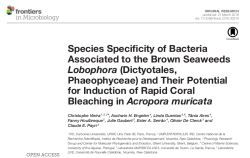
Dernier article ENTROPIE sur la spécificité des bactéries associées aux algues brunes du genre Lobophora :
Species Specificity of Bacteria Associated to the Brown Seaweeds Lobophora (Dictyotales, Phaeophyceae) and Their Potential for Induction of Rapid Coral Bleaching in Acropora muricata
Christophe Vieira, Aschwin H. Engelen, Linda Guentas, Tânia Aires, Fanny Houlbreque, Julie Gaubert, Ester A. Serrão, Olivier De Clerck and Claude E. Payri
While reef degradation is occurring worldwide, it is not uncommon to see phase shifts from coral to macroalgal dominated reefs. Numerous studies have addressed the mechanisms by which macroalgae may outcompete corals and a few recent studies highlighted the putative role of bacteria at the interface between macroalgae and corals. Some studies suggest that macroalgae may act as vectors and/or foster proliferation of microorganisms pathogenic for corals. Using a combination of high throughput sequencing, bacterial culturing, and in situ bioassays we question if the adversity of macroalgal-associated bacteria to corals is mediated by specific bacterial taxa. Using Illumina sequencing, we characterized and compared the bacterial community from two Lobophora (Dictyotales, Phaeophyceae) species. The two species presented distinctive bacterial communities. Both species shared approximately half of their OTUs, mainly the most abundant bacteria. Species-specific OTUs belong to Planctomycetes, Proteobacteria, and Bacteroidetes. In total, 16 culturable bacterial strain were isolated and identified from the Lobophora surface, consisting of 10 genera (from nine families, four classes, and three phyla), some of which are not known as, but are related to pathogens involved in coral diseases, and others are naturally associated to corals. When patches of marine agar with 24 h cultures of each of these bacteria were placed in direct contact with the branches of the scleractinian coral Acropora muricata, they caused severe bleaching after 24 h exposure. Results suggest that regardless of taxonomic affinities, increase in density of these bacteria can be adverse to corals. Nevertheless, the microbial community associated to macroalgal surface may not represent a threat to corals, because the specific bacterial screening and control exerted by the alga preventing specific bacterial proliferation.
Keywords: coral bleaching, Illumina sequencing, in situ bioassay, Lobophora, macroalgal–coral interaction, macroalgal bacterial assemblage, macroalgal culturable epibacteria